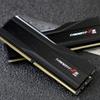Introduction
DDR5 Memory Scaling with G.Skill TridentZ5 6400 CL32 review
8x BIG and 8x Little but what memory frequency and latency?
Today we take a look at a G.Skill TridentZ5 6000 CL32 DDR5 kit and experiment with different frequencies to find where the performance sweet spot lies. Excuse me, but it's been a cluster frack to discover what the performance difference is compared to DDR4, but we've been testing with a sweet-spot 5200 MHz CL40 DDR5 kit, and as we've learned, latency counts. In that spirit, G.Skill released their latest DDR5 memory, the G.Skill Trident Z5 RGB DIMM kit 32GB, which is rated DDR5-6400 and offers CL32-39-39-102. G.Skill debuted three DDR5 series immediately away: the Trident Z5, the Trident Z5 RGB, and the Ripjaws S5. Surprisingly, all of the kits have 32GB (2x16GB) of storage, but none of them are accessible at the base 4,800MT/s speed. Latency is important, as this review will demonstrate, but what influence does sharper latency have on frequency? In that spirit, we'll put this memory kit through its paces at 3200 MHz, 4800 MHz, 5200 MHz, 6000 MHZ, and 6400 MHZ. The end outcome will be a little perplexing. DDR5 comes with new features like a Power Management Integrated Circuit, often known as a PMIC, which is responsible for controlling voltage changes. This effectively allows the DDR5 module to take over energy management and lessen the demand placed on the motherboard controller. Compared to DDR4, the nominal DDR5 voltage is 1.1 V, but the normal DDR4 voltage is 1.2 V. And while DDR4 is normally 1.35V XMP, it can be as high as 1.45V in some instances. When it comes to the XMP voltage, DDR5 is most likely using 1.25V. Talking XMP; DDR5 also introduced XMP 3.0, which is an update to the previous version. By raising the number of profiles from 3 to 5, it is possible to fine-tune the system. This could imply three profiles for manufacturer settings and even two placeholders for users to save their own profiles, depending on the configuration.
We all expected massive performance improvements from DDR5 memory. As it turns out that's not entirely the case. If you are purchasing a new system, it may be worthwhile to purchase DDR5 memory; however, it is expensive so you need to pick wisely and likely cost-effectively. The kit today for example passes 500 EUR at 31.50 EUR per GB. Our setup will be based on the sweet spot configurations; DDR5 5200 CL40 versus the new DDR5 6400MHz CL32 kit (2x 16GB). We'll be using the same Z690 HERO from ASUS as used in our previous articles to maintain consistency.


